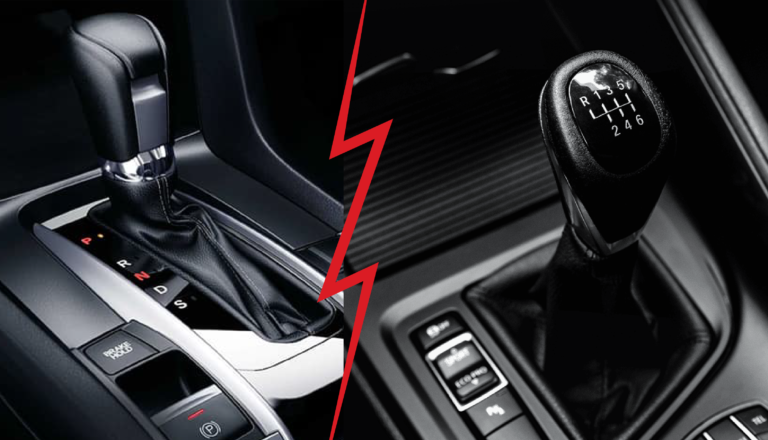
Your car’s transmission is like its nervous system—it directs power from the engine to the wheels, controlling speed and torque. Without it, your vehicle wouldn’t move efficiently. While all cars rely on a transmission, the way it operates differs significantly between manual and automatic systems.
Understanding the basics of manual and automatic transmissions helps drivers choose the right type for their lifestyle, budget, and driving preferences. This guide breaks down how each system works, their advantages, drawbacks, and the future of automotive transmissions.
A transmission is a gearbox that manages how much power the engine delivers to the wheels. Since engines generate power in a limited RPM range, the transmission ensures that power is usable at various speeds.
●
Multiplies torque for acceleration.
●
Adjusts speed for cruising.
●
Allows the vehicle to move forward and backward.
●
Enables the car to idle without stalling (in automatics).
There are two main types of transmission in consumer vehicles: manual and automatic.
Manual transmissions, also known as “stick shifts,” require the driver to operate a clutch pedal and gear lever.
1.
The clutch pedal disconnects the engine from the transmission.
2.
The driver selects the desired gear using the gearshift.
3.
The clutch re-engages, linking the engine to the new gear.
This process gives the driver full control over gear selection.
● Lower Cost:
Vehicles with manual gearboxes are generally cheaper upfront.
● Fuel Efficiency (Older Cars):
In older models, manuals often outperformed automatics in fuel economy.
● Durability:
Fewer complex components make them long-lasting.
● Driver Control:
Ideal for performance driving or off-road conditions.
●
Learning Curve :
Requires more skill and practice.
●
Traffic Hassle :
Constant clutch use can be tiring in stop-and-go traffic.
●
Resale Value :
Manuals are less popular today, affecting resale demand.
| Feature | Manual Transmission | Automatic Transmission |
| Control | Full control over gears | Automatic gear changes |
| Ease of Use | Requires clutch and gear shifting | Simple operation (just gas and brake) |
| Cost | Lower upfront and maintenance cost | Higher purchase and repair cost |
| Fuel Efficiency | Older manuals were better, modern automatics now lead | Often more fuel-efficient with modern tech |
| Durability | Long-lasting with fewer parts | Complex, but modern versions are highly reliable |
| Resale Value | Lower demand today | Higher demand among buyers |
In the past, manuals were considered more fuel-efficient. However, modern automatic transmissions with advanced software (like CVTs and dual-clutch systems) often achieve better gas mileage than manuals.
● Manual : Offers more engagement and control. Performance enthusiasts prefer manuals for sports cars.
● Automatic :
Provides smoother, stress-free driving. Great for daily commuting and long trips.
The rise of electric vehicles (EVs) is changing the role of transmissions. EVs don’t require multi-speed gearboxes since electric motors deliver instant torque. However, both manual and automatic transmissions still dominate gas-powered cars worldwide, with automatics becoming the overwhelming favorite.
Q1: Which is cheaper to maintain—manual or automatic?
A: Manuals are generally cheaper, but automatics are closing the gap with improved reliability.
Q2: Do manuals last longer than automatics?
A: Yes, in many cases, because they have fewer complex components. However, a poorly driven manual can wear out quickly.
Q3: Which is better for beginners?
A: Automatics are easier to learn. Manuals require more practice.
Q4: Do manuals still exist in new cars?
A: Yes, but they’re becoming rare. They’re still common in sports cars and budget-friendly models.
Q5: Can automatics be fun to drive?
A: Absolutely. Modern automatics with paddle shifters offer both convenience and performance.
Q6: What about CVT transmissions?
A: Continuously Variable Transmissions are a type of automatic, designed for smoother acceleration and better fuel efficiency.
When comparing manual vs automatic transmissions, the choice depends on your driving needs and lifestyle. If you value engagement, lower upfront costs, and durability, a manual could be right for you. If you prefer convenience, ease of use, and modern fuel efficiency, an automatic is the clear winner.
As automatics dominate the market, manuals are becoming a niche choice for enthusiasts. But no matter which you choose, understanding the basics ensures you make the best decision for your budget, comfort, and driving style.